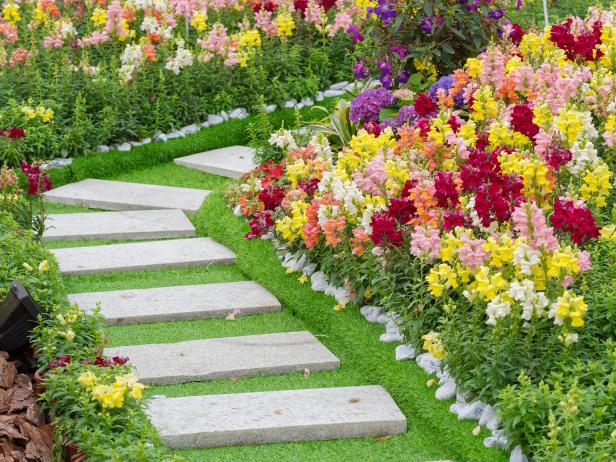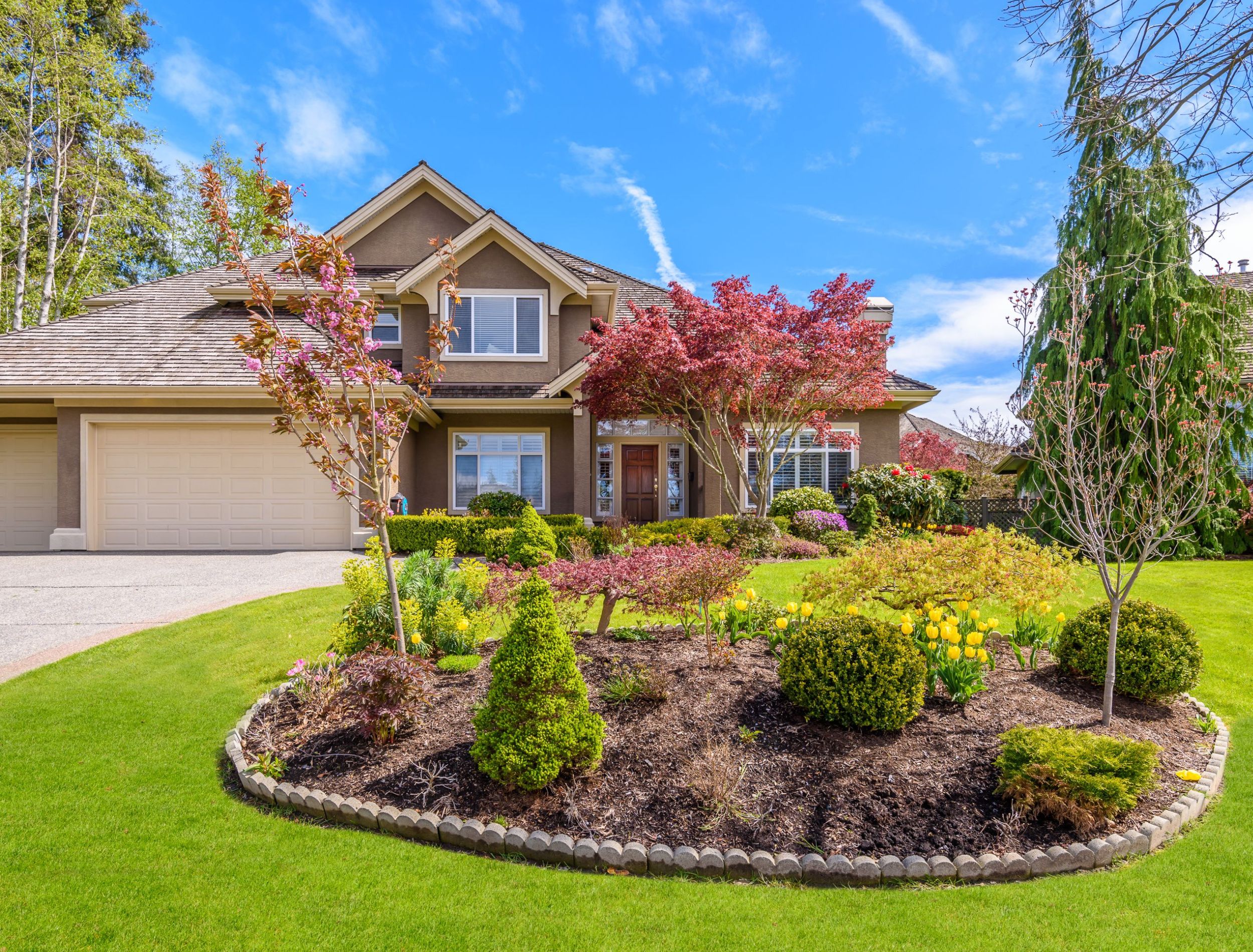Checking Out Different Types of Landscaping to Improve Your Outdoor Atmosphere
Landscape design plays a vital function in specifying outdoor areas. Numerous designs, from conventional yards to contemporary minimalist styles, use distinctive benefits for boosting aesthetic appeals and function. Incorporating elements like xeriscaping and indigenous plants can add to environmental balance. Recognizing the interplay of hardscape and softscape is essential for producing inviting atmospheres. The choices readily available can be frustrating, triggering one to review which design best lines up with their vision for an exterior haven.
Conventional Garden Landscape Design

While several modern gardens accept minimalism and native growings, conventional yard landscaping remains a treasured method that emphasizes balance, framework, and decorative attributes. This design usually includes formal geometric layouts, where hedges, pathways, and flowerbeds are organized with accuracy. Central prime focus, such as fountains or sculptures, attract the eye and offer a sense of harmony.Traditional landscaping often consists of a selection of plant kinds, showcasing seasonal flowers and evergreen aspects. Timeless bushes, perennials, and annuals produce lively shades and structures throughout the year. Furthermore, trellises, pergolas, and arcs include upright passion and function as assistance for climbing plants, boosting the overall aesthetic.The use natural products, such as stone and wood, more enhances the standard landscape, contributing to a classic top quality. Eventually, this design invites relaxation and pleasure, making it a cherished option for those seeking an attractive outdoor environment.
Modern Minimalist Landscape Design
Modern minimalist landscape design stresses simplicity and performance, defined by clean lines and open rooms. Key attributes include a minimal plant scheme and thoughtful hardscape design that focuses on use and visual charm. Reliable plant selection approaches better boost the minimalist strategy, producing serene exterior atmospheres that urge relaxation and consideration.
Trick Features of Minimalism
An expanding trend in landscaping is the welcome of minimalism, defined by simpleness and performance. Minimalist landscaping focuses on tidy lines, open areas, and a limited shade combination, advertising a feeling of harmony. Components are very carefully curated to prevent mess, permitting each component to stand apart. Making use of natural products, such as stone and timber, improves the organic feeling while preserving a visual balance. In addition, minimalist styles usually include geometric forms, which can create aesthetic interest without frustrating the detects. Water attributes might be consisted of, serving as prime focus that enhance calmness. On the whole, minimalism in landscaping highlights the beauty of restriction, permitting nature's inherent top qualities to shine through in an unified exterior atmosphere.
Plant Choice Techniques
Efficient plant choice is important for attaining the desired visual in modern-day minimalist landscape design. The focus needs to get on simplicity, making use of a limited palette of plants that complement each other and the surrounding environment. Indigenous plants are often perfect, as they require much less upkeep and water, advertising sustainability. Choosing species with differing elevations and appearances can add visual interest without overwhelming the room. Organizing plants in clusters instead of spreading them enhances communication and reinforces the minimalist motif. Evergreen ranges can provide year-round structure, while seasonal blooms introduce subtle color modifications. Inevitably, the objective is to produce a tranquil outdoor space that embodies harmony and consistency with thoughtful plant choices.
Hardscape Style Concepts
Necessary elements in hardscape style significantly contribute to the total aesthetic appeals and functionality of minimal landscape design. This layout technique stresses clean lines and downplayed materials, developing a clean visual experience. Secret elements include paths, patios, and maintaining walls, which not just define areas yet additionally improve access and functionality. Making use of products such as concrete, rock, and wood is widespread, showing an all-natural yet modern visual. Incorporating geometric shapes and in proportion formats even more reinforces the minimal viewpoint, enabling an unified mix with bordering greenery. Furthermore, appropriate drainage and erosion control are vital considerations, guaranteeing long life and sustainability. Inevitably, effective hardscape layout works as a foundation that complements softscape components while preserving balance and simplicity in exterior atmospheres.
Cottage-Style Landscape design
Cottage-style landscaping provides a delightful technique to creating inviting outdoor areas. By incorporating enchanting plant mixes, this style cultivates a sense of warmth and fancifulness. The emphasis on cozy, distinct areas encourages relaxation and satisfaction of nature.
Captivating Plant Combinations
Many homeowners seek to produce a picturesque outside area, attaining the beauty of cottage-style landscaping commonly hinges on thoughtful plant combinations. Dynamic blooms, lush foliage, and aromatic natural herbs can be skillfully matched to stimulate a feeling of whimsy and nostalgia. Combining lavender, daisies, and foxgloves produces a colorful tapestry that brings in pollinators while providing a wonderful scent. Including ornamental lawns like miscanthus can add structure and motion, enhancing the softer blossoms. Furthermore, blending yearly and seasonal plants assurances constant color throughout the seasons. The use of mountain climbers, such as clematis or honeysuckle, can enhance upright passion. Overall, these mixes not just enhance the landscape yet additionally cultivate a inviting and bewitching ambience.

Relaxing Outside Rooms
Developing comfortable exterior spaces requires a careful blend of comfort and beauty, matching the dynamic plant combinations discovered in cottage-style landscaping - Landscape Lighting Installer. These locations commonly include welcoming seating setups, such as weather-beaten wooden benches or supported chairs bordered by lush greenery. Soft lights, like fairy lights or lights, adds warmth, transforming the area right into a peaceful retreat. Incorporating aspects such as trellises decorated with climbing up roses or aromatic natural herbs improves sensory experiences. Additionally, paths constructed from rustic stones invite exploration and link with nature. Decorative touches like birdbaths or whimsical yard art add to a feeling of whimsy. Inevitably, the objective is to produce an enchanting environment that urges leisure and pleasure of the charm surrounding these cozy outdoor places
Xeriscaping for Water Preservation
Just how can communities stabilize visual landscaping with journalism demand for water sites preservation? Xeriscaping becomes a practical service, advertising sustainable techniques that reduce water use while improving outdoor elegance. This landscaping method concentrates on utilizing drought-resistant plants belonging to the region, which call for substantially much less water than standard gardens. By integrating mulch and efficient irrigation systems, xeriscaping lowers dissipation and overflow, additional saving priceless water resources.Communities can develop visually attractive landscapes with mindful planning, selecting a varied selection of appearances and colors that thrive in arid problems. Furthermore, xeriscaping urges the use of ornamental rocks and ornamental crushed rock, using appealing and useful choices to turf yards. As communities embrace this green method, they not only minimize their water usage however also advertise biodiversity and resilience in their neighborhood environments. Eventually, xeriscaping acts as a presentation of the harmony between visual appeal and ecological responsibility.
Hardscape Layout Aspects
Hardscape style components play a crucial function in enhancing outside areas by supplying structure and performance. These non-plant functions, such as outdoor patios, wall surfaces, pathways, and decks, create aesthetic Retaining Wall Installation interest while offering sensible purposes. Making use of products like rock, concrete, and block, hardscaping adds to the overall visual charm and sturdiness of a landscape.Incorporating hardscape components can define areas within a lawn, directing motion and encouraging social interaction. A well-placed pathway can attach different sections of the garden, while keeping walls can take care of elevation changes and stop erosion.Furthermore, hardscape style can boost accessibility and safety and security, offering secure surfaces for lounging or walking. Effective assimilation of hardscape parts complements soft landscape design, guaranteeing a balanced exterior atmosphere. Ultimately, thoughtful hardscape design improves not just the appeal of exterior rooms but additionally their use, making them much more inviting and useful for site visitors and home owners alike.
Outdoor Living Rooms
While exterior space provide a smooth mix of comfort and nature, they work as necessary extensions of a home, enhancing way of living and recreation. These areas can include outdoor patios, decks, or outside cooking areas, created to cultivate leisure and entertainment. Bbq Island Installation. By including functional furnishings and elegant style, home owners develop inviting atmospheres for events or silent evenings.The combination of color frameworks, such as pergolas or awnings, shields versus the components while preserving an open feel. Fire pits and outdoor heating systems expand use right into cooler months, supplying warmth and ambiance. In addition, integrating lighting features boosts the area's usability after sunset, producing a wonderful night atmosphere.Landscaping components, such as boundaries and paths, additionally specify these locations, guiding movement and including visual allure. Inevitably, outdoor living rooms transform backyards into functional hideaways, advertising a lifestyle that embraces both nature and convenience
Indigenous Plant Landscaping
Native plant landscape design stresses making use of native have a peek at this website vegetation to create unified and sustainable exterior atmospheres. This approach not just boosts biodiversity but additionally preserves water and lowers the demand for chemical fertilizers and pesticides. By choosing plants that are native to a specific region, home owners can guarantee that their landscapes are well-adapted to neighborhood soil and climate conditions, causing reduced maintenance requirements.Additionally, indigenous plants offer vital environments for local wild animals, including butterflies, birds, and bees, advertising environmental health. Landscape designs that incorporate these plants usually include naturalistic formats that resemble local ecological communities, cultivating a feeling of area and link to the environment.Furthermore, indigenous plant landscaping can add to dirt stability and erosion control, making it an eco liable selection. In general, this method not only enhances outside rooms yet likewise supports the local community, developing a sustainable balance in between human task and nature.

Frequently Asked Inquiries
Just How Can I Choose the Right Landscaping Design for My Home?
Choosing the best landscaping style for a home involves examining the home's architecture, climate, and personal choices. Grill Islands. Researching numerous designs and consulting professionals can give advice to create a harmonious exterior area tailored to private needs
What Is the Average Expense of Expert Landscaping Services?
The typical cost of professional landscaping services generally varies from $1,000 to $5,000, depending on job size, complexity, and area. Property owners need to think about obtaining numerous quotes to ensure they get reasonable pricing and high quality solution.
How Usually Should I Keep My Designed Backyard?
The regularity of keeping a designed lawn typically depends on the attributes and plants existing. Generally, regular maintenance every few weeks is advised, with seasonal jobs raising in regularity throughout top growing seasons for suitable wellness and visual appeals.
Exist Landscaping Choices for Tiny Urban Spaces?

Different landscaping choices exist for little city rooms, including upright gardens, container plants, and roof gardens. Integrating these components can take full advantage of restricted areas while providing plant, enhancing appearances, and improving air high quality in urban settings.
What Plant kingdom Are Best for Bring In Neighborhood Wild Animals?
The most effective plants for attracting local wildlife consist of native blooming types, berry-producing hedges, and varied lawns. These plants give important food and environment, fostering a growing community that sustains various birds, bugs, and little mammals. Several homeowners seek to create a picturesque outside space, attaining the charm of cottage-style landscape design usually pivots on thoughtful plant combinations. Producing comfy outside spaces requires a mindful mix of comfort and beauty, matching the vivid plant mixes found in cottage-style landscape design. Indigenous plant landscaping stresses the use of indigenous vegetation to create sustainable and harmonious exterior environments. Landscape designs that incorporate these plants frequently include naturalistic layouts that imitate local ecosystems, fostering a sense of area and connection to the environment.Furthermore, native plant landscape design can add to soil security and erosion control, making it an environmentally responsible choice. Various landscaping options exist for small metropolitan rooms, including vertical gardens, container plants, and roof gardens.